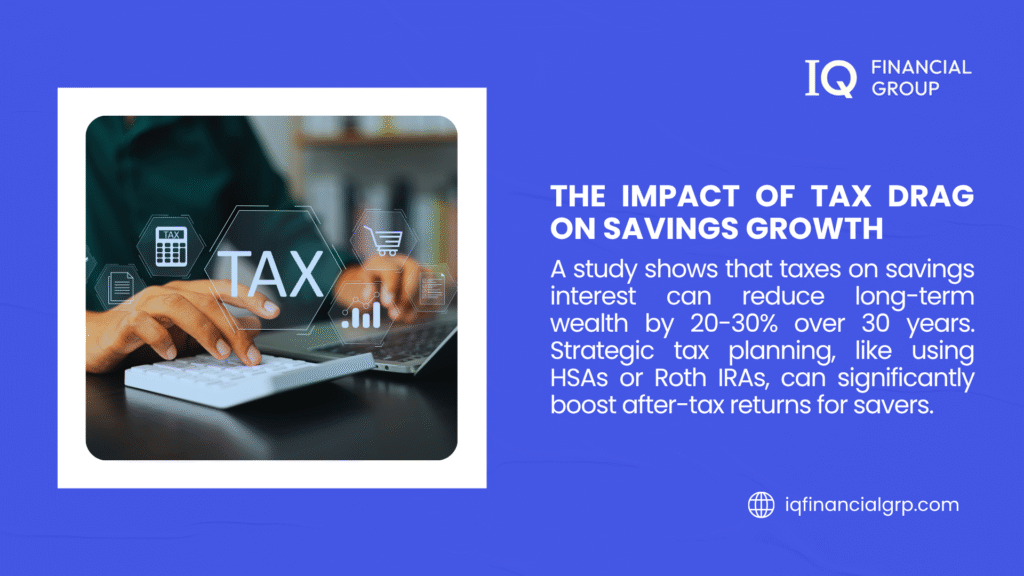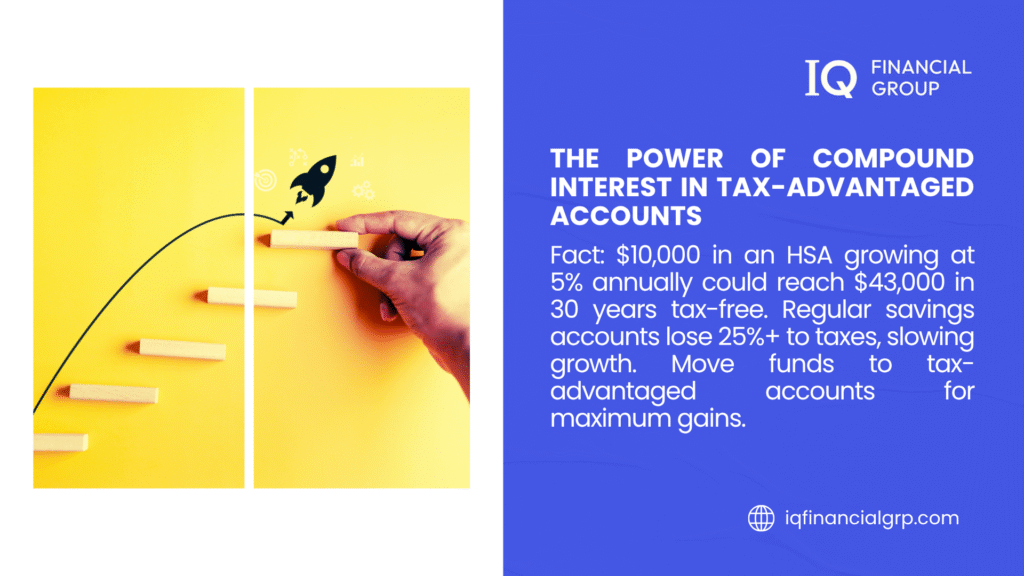Most people think there isn’t much they can do about taxes on their savings account. Every year, they get that 1099-INT form and just accept that they have to pay taxes on whatever interest they earned. But that thinking is wrong, and chances are, many savers are making this same costly mistake.
Learning how to avoid tax on savings account interest does require some strategy. And once people start seeing the difference in their take-home savings, they wonder why they didn’t start sooner.
Understanding these strategies, both straightforward and more complex ones, can make a real difference in anyone’s bottom line. All of them are completely legal and can significantly impact long-term wealth building.
Why Regular Savings Accounts Are Costing Money
That “safe” savings account could be quietly eating away at wealth through taxes. Every penny of interest earned gets added to taxable income, which means paying the full tax rate on it.
Consider this scenario. Someone in the 22% tax bracket earning $500 in interest gives $110 of that straight to the government. Add state taxes on top of that, and they might be looking at losing 30% or more of their interest earnings.
This doesn’t mean avoiding savings accounts entirely. They serve a purpose, especially for emergency funds. But for serious wealth building, thinking beyond that basic savings account is essential.
The IRS doesn’t care if money is actually withdrawn or not. They want their cut as soon as it’s earned. This differs from investments where there might be some control over when taxes are paid. With savings account interest, taxes are due every single year, whether it’s convenient or not.
Health Savings Accounts Offer the Best Tax Deals
For those eligible for a health savings account, they’re sitting on one of the best tax deals the government offers. These accounts provide triple tax benefits, something that’s pretty rare.
Here’s how it works. Money goes in tax-free, it grows tax-free, and it can be withdrawn tax-free for medical expenses. Even better, after age 65, the money can be used for anything (though regular income tax applies to non-medical withdrawals).
The contribution limits are generous too. For 2024, individuals could have contributed $4,150 or $8,300 for family coverage. Those 55 or older get an extra $1,000 catch-up contribution.
Some people worry about not having many medical expenses. The reality is most people have more than they think. Health insurance covers a lot of things, but there are still plenty of out-of-pocket costs. Plus, as people age, those medical expenses tend to add up.
The good thing about HSAs is that the money never expires. It can sit there for decades, growing tax-free, and be used later when it’s really needed. Some people even use their HSA as a retirement account because of these amazing tax benefits.

Smart Moves with IRAs and Other Retirement Accounts
Another solid strategy for how to avoid tax on savings account interest involves moving some of that money into retirement accounts. While accessibility might be a concern, there are options that provide flexibility.
Roth IRAs are particularly interesting because contributions can always be withdrawn without penalty. The growth needs to stay put until age 59½, but original contributions are accessible. Money goes in after-tax, but everything grows tax-free from there.
Traditional IRAs work differently. There might be a tax deduction now, but taxes are paid when money is withdrawn in retirement. The key is thinking about whether tax brackets will be higher or lower later.
Here’s a strategy that works well for many people: they keep their emergency fund in a regular savings account (because easy access to that money is needed), but they move their longer-term savings into IRAs. It’s not right for everyone, but it can be a smart move for disciplined savers.
The HRA Advantage and Other Employee Benefits
If an employer offers a Health Reimbursement Arrangement (HRA), that’s another way to save on taxes. While contributions can’t be made directly, employers can reimburse tax-free for medical expenses. This effectively reduces taxable income.
The key is keeping good records of medical expenses. Everything from eye exams to vasectomy procedures might be covered, depending on the plan. Even things like braces or chiropractor visits could qualify.
Other employee benefits shouldn’t be forgotten either. If a company offers a flexible spending account (FSA), that’s another way to set aside pre-tax dollars for medical expenses. The downside is the “use it or lose it” rule, but for predictable expenses, it can be a great tax saver.
Tax-Free Savings Account Alternatives
While the U.S. doesn’t have a true tax free savings account like some other countries, there are ways to get similar benefits. Municipal bonds are one option, the interest is usually exempt from federal taxes, and sometimes state taxes too.
The trade-off is typically lower yields, but for those in high tax brackets, the after-tax return can actually be better than taxable investments. The numbers need to be calculated based on specific situations.
529 education savings plans are another option for those with kids or grandkids. After-tax money goes in, but it grows tax-free and comes out tax-free for qualified education expenses. These plans have gotten more flexible over the years too. Money can be used for K-12 tuition, trade schools, and even student loan payments.

Timing Strategies on How to Avoid Tax on Savings Account
Sometimes, knowing how to avoid tax on savings account interest comes down to timing. If someone knows they’ll be in a lower tax bracket next year (maybe they’re retiring or taking time off), they might want to defer some income or accelerate some deductions.
This gets a bit tricky and might require professional help, but the savings can be substantial. For example, if someone is right on the edge of a tax bracket, small moves can make a big difference in their overall tax bill.
Another timing strategy involves bunching deductions. Instead of spreading charitable donations over several years, bunching them all in one year to exceed the standard deduction threshold might work. This doesn’t directly affect savings account taxes, but it can lower the overall tax rate.
What About High-Yield Savings Accounts?
Here’s a common question: “Should money be moved to a high-yield savings account?” The answer depends on the situation, but generally, yes – earning more interest is better than earning less, even if taxes have to be paid on it.
The key is looking at after-tax returns. A high-yield account paying 4% might give a better after-tax return than a municipal bond paying 3%, depending on tax brackets. The math needs to be done based on specific situations.
Online banks often offer the best rates, and many of them are just as safe as traditional banks (making sure they’re FDIC insured is important). The extra interest can add up over time, even after taxes.
Common Mistakes That Cost Money
One mistake people make is not reporting small amounts of interest income. Even without receiving a 1099-INT, all interest income still needs to be reported. The IRS has ways of finding out, and penalties can be much worse than the original tax owed.
Another mistake is putting too much money in tax-advantaged accounts. Each account type has limits, and exceeding them can result in penalties. For example, if too much goes into an HSA, there’s a 6% penalty every year until it’s fixed.
Some people also make the mistake of focusing only on taxes without considering their overall financial picture. Yes, minimizing taxes is important, but not at the expense of having enough liquid savings for emergencies or other goals.

When Professional Help Makes Sense
Some of this stuff can get complicated. Tax laws change, contribution limits change, and what works for one person might not work for another. Sometimes it makes sense to get professional help.
A good financial advisor can help figure out the best strategy for specific situations. They can also help avoid costly mistakes and identify opportunities that might be missed.
The key is finding someone who understands both taxes and personal financial goals. The cost of good advice often pays for itself through the money saved and mistakes avoided.
Making It Happen in Real Life
So how do people actually implement these strategies? Start simple. If someone is eligible for an HSA, that’s often the best place to start. The tax benefits are hard to beat, and the money can be used for medical expenses now or in retirement.
Next, make sure any employer matching on retirement accounts is maximized. That’s free money, and it reduces current taxable income too.
Then look at the overall savings strategy. How much is needed in easily accessible savings versus longer-term savings? Money that doesn’t need immediate access might be better suited for tax-advantaged accounts.
| Strategy | Tax Benefit | Accessibility | Best For |
| HSA | Triple tax advantage | Limited to medical expenses | Anyone eligible with high-deductible health plan |
| Roth IRA | Tax-free growth | Can withdraw contributions anytime | Long-term savers who expect higher future tax rates |
| Traditional IRA | Tax deduction now | Penalties for early withdrawal | People who expect lower tax rates in retirement |
| 529 Plan | Tax-free growth for education | Education expenses only | Parents or grandparents saving for education |
Taking Action on Tax Savings
Learning how to avoid tax on savings account interest is about using the tools the tax code already provides in a smart way.
The strategies discussed can save real money, but they work best when they’re part of a bigger financial plan. That’s where having professional guidance can make a huge difference.
Ready to take control of your financial future and stop overpaying on taxes? At IQ Financial Group, we help people develop smart, tax-efficient savings strategies that actually work.
Our team knows exactly how to navigate these complex tax rules and can create a personalized plan that fits unique situations.

